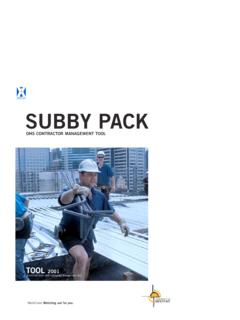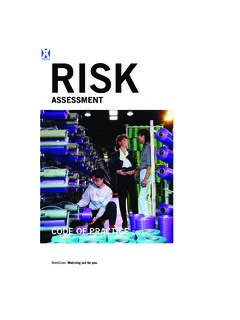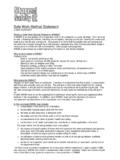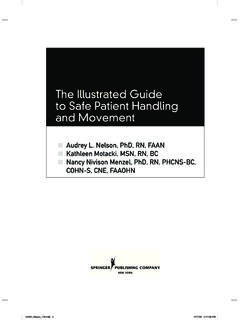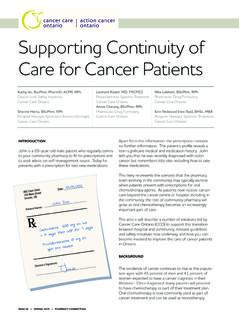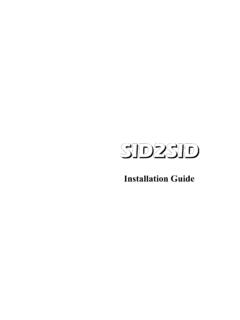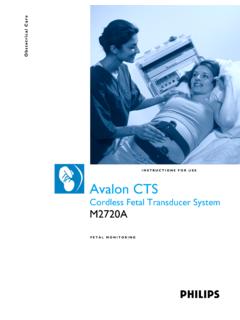Transcription of Reading Labels and Material Safety Data Sheets: …
1 Reading Labels AND Material Safety data SHEETSWorkCover. Watching out for TO FIND OUT ABOUT CHEMICALS USED IN YOUR WORKPLACEGUIDE 2006 Revised 3rd edition 2006 DisclaimerThis publication contains information regarding occupational health, Safety , injury management or workers compensation. It includes some of your obligations under the various workers compensation and occupational health and Safety legislation that WorkCover NSW administers. To ensure you comply with your legal obligations you must refer to the appropriate publication may refer to WorkCover NSW administered legislation that has been amended or repealed. When Reading this publication you should always refer to the latest laws.
2 Information on the latest laws can be checked at or contact 1300 656 986. WorkCover NSW1 The purpose of this guideWhat is this guide about?This guide will help workers obtain health and Safety information by Reading and understanding Labels on containers of chemicals, and the Material Safety data sheets (MSDS) relating to chemicals they use. Who is this for?This guide is for workers who use chemicals supplied to their workplace. Trainers will also find this useful when conducting courses. Why use this guide ?When using chemicals, workers have a right to the following information: know what the chemical is where to get advice and information about the chemicals what the hazards and risks are when using it how to be protected from harm that could arise from the risks.
3 The Occupational Health and Safety Regulation 2001 requires employers to provide instruction and training to help employees understand the information on Labels and in MSDS, and how to apply this information. When should this guide be used?This guide should be used in all workplaces where chemicals are used. It will help workers recognise Labels , and help them find information in Material Safety data Sheets (MSDS). This guide will also be useful as a training tool. 2 Chemicals in the workplaceChemicals used in the workplace can be placed into the following three overlapping groups: hazardous substances dangerous goods scheduled chemical can be classified as a hazardous substance and/or a dangerous goods and/or a scheduled poison.
4 Not all hazardous substances are also classified as dangerous goods and so the container will not necessarily have a dangerous goods label . This is because the dangerous goods diamond indicates an immediate hazard and not a long term health risk. Hazardous substances are chemicals harmful to health. This includes short term effects (such as poisoning) and long term effects (such as causing cancer). Dangerous goods have an immediate physical risk (such as fire or explosion), or an immediate health risk (such as rapid poisoning). Scheduled poisons are classified on the basis of health hazards this classification is used for chemicals available for domestic use and for pesticides.
5 Poisons are listed in a schedule known as the SUSDP (Standard for the Uniform Scheduling of Drugs and Poisons). Such domestic chemicals (including items such as cleaners, pesticides and solvents) are usually sold in retail outlets (in consumer packages), but may also be used in workplaces so workers need to be aware of this labelling. Key health and Safety information is provided on Labels , and more detailed information is provided in Material Safety data Sheets (MSDS). What does the law say about providing Labels and MSDS in workplaces?Legal obligations are specified in the Occupational Health and Safety Regulation 2001 (OHS Regulation). Manufacturers are required to classify chemicals and prepare Material Safety data Sheets (MSDS).
6 Importers must ensure that the manufacturer s responsibilities are met. Suppliers are required to provide Labels on containers and MSDS for those chemicals classified as hazardous substances or dangerous goods that they supply to workplaces. Bulk containers, such as tanks, sent to your workplace must have placards that indicate their dangerous goods classification if they contain dangerous goods. If chemicals are transferred to other containers, such as by decanting, suitable labelling needs to be maintained, similar to that on the original container unless the chemical is consumed immediately in a process. Employers must ensure that Labels are applied to containers and that MSDS are made accessible to workers who may be exposed to the chemicals.
7 All hazardous substances and dangerous goods used in the workplace must be listed on a register together with the relevant MSDS. Employees must have access to this register. Training should ensure that workers who use chemicals can read and understand relevant Labels and MSDS. 3 Reading labelsReading the Labels on containers and packages is the first step in getting health and Safety information on the chemicals used. It is important to recognise symbols and read Labels so that you can take steps to protect the health and Safety of yourself and others. Read the label to find out the following information: the product name or trade name (you need this if you want to get the correct MSDS) the proper name for the chemical and its ingredients any possible Safety risks or health effects advice on how to use the chemical classified as hazardous or dangerous have Labels that show the following: a symbol or key word indicating the relevant hazards (a) the dangerous goods diamond , or (b) the word Hazardous , or (c) a word providing a warning (such as dangerous poison or caution ).
8 Product name chemical names risk information directions for use Safety information first aid directions emergency procedures supplier contact details reference to the corresponding to interpret signs and words on labelsFirst, look to see if the label shows a dangerous goods diamond , the word hazardous or another warning. Diamond Labels dangerous goods If a chemical is classified as a dangerous goods, it will have a diamond sign(s) that indicate the type of hazard. These symbols are illustrated on page 6. For example, a dangerous goods diamond label for a toxic substance looks like this:4 The hazardous label hazardous substancesIf a chemical is hazardous, the container label will have the word hazardous , usually in red.
9 HAZARDOUSThe risk and Safety phrases on the label give more detail as to the nature of the hazard and precautions to take. Sample of a hazardous substances labelHAZARDOUSMOCA4,4 Methylenebis (2 chloroaniline)500gmRiskMay cause cancer. Harmful if exposure obtain instructions before suitable protective AidIn case of accident or if you feel unwell contact a doctor or Poisons Information Centre immediately (show the label where possible). Transfer patient to fresh air. If breathing has stopped begin artificial respiration immediately. Wash exposed skin or eye thoroughly with water. If ingested have victim drink 250ml of trained personnel should clean up.
10 Use impervious protective clothing, for example, nitrile rubber, and respirators. Contain spill with sand or absorbent Material . Shovel solid Material into clean dry labelled containers and on current available information MOCA does not information is listed in the Material Safety data , 15 Bunch TOWN QLD 4567 Ph: (071) 369 72415 The poisons label (for poisons primarily for domestic use)Some containers may have a signal word which is one of the following, shown in order of increasing risk:CAUTIONWARNINGPOISONDANGEROUS POISONThis indicates that the substance in the container is a scheduled poison. This labelling is used pesticides and commonly available domestic chemicals, such as those available from retail outlets such as hardware stores.
